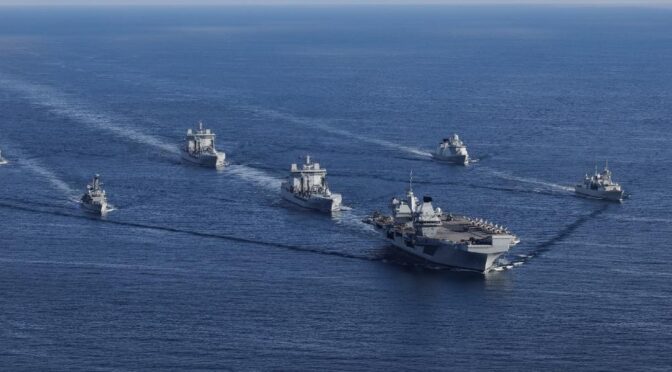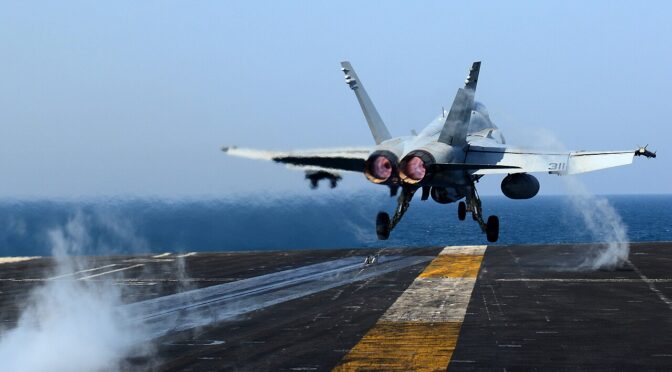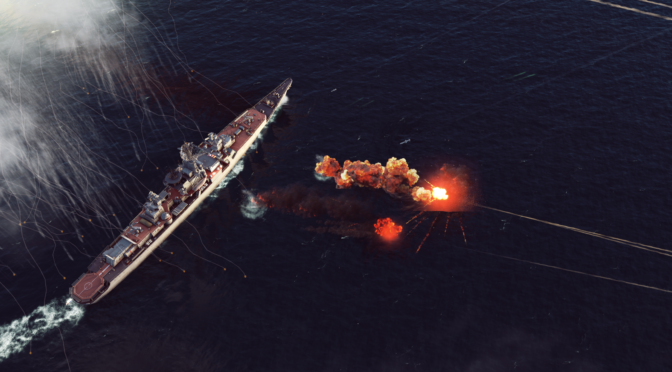By Walter Berbrick and Terence Nicholas
Based on our experience designing and analyzing recent Naval War College wargames in the Euro-Atlantic theater, U.S. and NATO maritime forces face several challenges in maintaining readiness, enhancing lethality, and accelerating decision-making—core priorities underscored by U.S. Defense Secretary Pete Hegseth. The North Atlantic and High North are increasingly contested, as Russian submarine operations and grey zone activities intensify and China extends its influence deeper into strategically critical Atlantic corridors.
There are several areas where greater alignment between U.S. and NATO maritime forces could enhance warfighting readiness and crisis response. These include streamlining command relationships, enhancing maritime domain awareness, harmonizing rules of engagement, strengthening maritime logistics, integrating NATO into North American defense planning, and improving amphibious force employment. While NATO navies bring significant capability to bear, optimizing these areas will ensure that the alliance is positioned to deter aggression, enhance decision advantage, and maintain maritime superiority in an increasingly complex and contested security environment.
This article offers insights and recommendations based on our wargaming experience to help U.S. and NATO naval leaders strengthen operational integration, refine force employment, and better prepare for future maritime challenges in the Euro-Atlantic theater.
Streamline Unity of Effort in the Atlantic and High North
With multiple U.S. and NATO maritime commands operating across the Atlantic and High North, there is a valuable opportunity to enhance unity of effort by refining command relationships, synchronizing force employment, and accelerating decision-making. Effective coordination among U.S. Naval Forces North (NAVNORTH), U.S. Naval Forces Europe (NAVEUR), NATO Maritime Command (MARCOM), and Striking Forces NATO (SFN) ensures that Allied maritime forces can operate seamlessly in a contested environment. Wargame insights consistently emphasize the importance of shared mission awareness, mission command, and persistent training to reinforce operational alignment and clarify multinational naval task force responsibilities.
Recent initiatives have bolstered deterrence in the Euro-Atlantic theater, such as the establishment of a second maneuver fleet under NAVEUR’s temporary control and a forward deployed expeditionary Maritime Operations Center (MOC) in Europe. These efforts have improved multi-echelon coordination and operational flexibility between U.S. and NATO maritime forces, demonstrating the benefits of closer integration. Additionally, refining command integration between SFN and MARCOM—two key NATO maritime components—presents a further opportunity to strengthen transatlantic force employment. SFN, responsible for high-end maritime strike capabilities, reports directly to SACEUR, while MARCOM serves as both NATO’s Combined Force Maritime Component Commander (CFMCC) and the Maritime Component Commander for multiple Joint Force Commands (JFCs). Ensuring secure communications, clear command authorities, and persistent joint training will enhance NATO’s ability to employ maritime forces rapidly and effectively at the task force and task group levels.
Another key step toward greater unity of effort is elevating JFC Norfolk to a 4-star command. As NATO’s only transatlantic operational command, JFC Norfolk serves a vital role in linking U.S. and NATO maritime operations, yet its current structure requires balancing U.S. and Allied priorities across multiple echelons. Elevating JFC Norfolk would enhance command focus on transatlantic operations, improve decision-making agility, and better align command relationships within NATO’s maritime architecture. Most importantly, structuring Allied maritime commands for crises and conflict—rather than peacetime—will ensure standing U.S. and NATO maritime forces and planners are ready and integrated to deter aggression and respond decisively in the Atlantic and High North.
Enhancing Maritime Domain Awareness and Situational Awareness
U.S. and NATO maritime forces have a unique opportunity to sharpen their maritime domain awareness (MDA) and situational awareness by strengthening intelligence-sharing and coordination across the Atlantic and High North. Both forces field some of the world’s most advanced intelligence, surveillance, and reconnaissance (ISR) and anti-submarine warfare (ASW) capabilities, but their full potential can only be realized through seamless integration of policies, technologies, and operational procedures. Enhancing coordination between key commands—NAVEUR, NAVNORTH, MARCOM, and SFN—will create a more comprehensive and real-time picture of the maritime battlespace, enabling faster threat detection, more agile decision-making, and greater operational effectiveness in contested environments.
A critical step toward this goal is developing a federated Common Operating Picture (COP) that integrates multi-domain sensor data from both U.S. and NATO maritime forces. This approach would reduce ISR fragmentation, allowing commanders to detect, track, and respond to threats with greater speed and precision. Whether countering adversary submarine movements, grey-zone activities, or long-range maritime threats, a more connected ISR network would enhance decision-making, improve force employment, and reinforce deterrence, ensuring NATO and U.S. maritime forces maintain a strategic advantage in dynamic operational theaters.
However, technology alone is not the answer. Persistent joint training, operational scenario-driven wargames, and multinational staff exchanges will be essential to refining intelligence-sharing processes and breaking down procedural barriers. Regular stress-testing of ISR coordination in realistic threat conditions will enhance interoperability, clarify authorities, and increase confidence across the alliance. By taking these steps, U.S. and NATO maritime forces will build a more unified, resilient, and responsive transatlantic naval force—one that can anticipate, deter, and decisively respond to emerging threats in an increasingly contested maritime security environment.
Maximizing Authorities and Rules of Engagement
In fast-moving maritime operations, commanders need the ability to act swiftly and in sync with their allies. U.S. and NATO forces operate under different Rules of Engagement (ROE) and authorities, but instead of seeing this as a constraint, there’s an opportunity to leverage these differences to enhance operational agility. A deeper understanding of how each nation’s approval processes work—who can authorize what and when—can reduce delays, increase interoperability, and open the door to more flexible force employment. When commanders operate with shared awareness of authorities, they are better equipped to act decisively and prevent adversaries from exploiting procedural gaps.
Expanding this understanding is a practical step toward greater coordination and combat effectiveness. If commanders know when and how NATO and U.S. assets can operate under each other’s authorities, they can more effectively integrate forces in real time. For example, U.S. and NATO surface and submarine forces could be tasked interchangeably in a crisis, making force posture more dynamic and responsive. Instead of working around bureaucratic seams, commanders could focus on maximizing the collective strength of the alliance to deter and respond to threats with greater speed and cohesion.
To further streamline decision-making, establishing pre-approved Crisis Response Options and real-time coordination cells would allow forces to act immediately when needed. Setting clear engagement triggers across all warfare domains—surface, subsurface, air, cyber, and electronic warfare—would synchronize responses across NATO and U.S. maritime forces, closing decision-making gaps that adversaries might otherwise exploit. Aligning ROE where possible, increasing transparency of authorities, and enabling faster approvals will ensure that U.S. and NATO maritime forces can operate as a unified force, projecting deterrence and strength in an increasingly complex security environment.
Enhancing Operational Resilience
Sustaining maritime operations in the Atlantic and High North is not just about moving fuel, munitions, and supplies—it’s about ensuring forces can stay in the fight when and where they’re needed most. The ability to rapidly resupply ships at sea, repair battle damage, and sustain operations away from fixed infrastructure is what separates an agile, combat-ready force from one that risks being sidelined when it matters most. Wargaming has provided a valuable way to stress-test sustainment strategies, identify weak points before they become real-world problems, and explore new ways to keep fleets operational in contested environments.
A major takeaway from these efforts is the importance of stronger coordination between key sustainment commands like NAVNORTH, NAVEUR, MARCOM, and SFN. In fast-moving operations, small misalignments in logistics planning can lead to big problems. Establishing dedicated logistics coordination cells and integrating sustainment planning more deeply into operational decision-making can help ensure the right resources are available at the right time. The more aligned NATO and U.S. sustainment efforts become, the better prepared forces will be to sustain prolonged operations across the Atlantic.
Another critical piece is expeditionary logistics—the ability to keep ships on station without having to pull back to port for resupply and repairs. While the U.S. has made significant advances in vertical replenishment (VERTREP) and at-sea rearming, many NATO warships still rely on fixed facilities, which limits flexibility. Expanding interoperability in afloat logistics, forward-deploying repair capabilities, and developing mobile resupply facilities will keep ships in the fight longer. Additionally, prepositioning sustainment stockpiles across North America and Europe will help reduce dependence on major ports and ensure forces remain operational regardless of access challenges. Logistics isn’t just a support function—it’s a warfighting necessity. The ability to sustain combat operations anytime, anywhere will be a decisive factor in maintaining maritime superiority in the Atlantic.
Expanding U.S.-NATO Naval Integration for North American Defense
As security dynamics in the Atlantic and High North continue to evolve, there is a growing opportunity to strengthen U.S.-NATO naval integration and expand cooperation in North American defense. Traditionally, NATO’s maritime forces have focused on collective defense under Article 5, while homeland defense responsibilities have remained largely within national command structures. However, as adversaries increase activity across the Atlantic, greater alignment between U.S. and NATO maritime forces can enhance deterrence, improve crisis response, and provide more flexible force employment options.
One way to achieve this is by better integrating NATO maritime forces into existing U.S. defense planning and operations. Coordination among NAVNORTH, MARCOM, and SFN has often been episodic rather than institutionalized, making it more reactive than proactive. By establishing routine collaboration, expanding NATO’s operational footprint in the Western Atlantic and Arctic, and refining joint maritime situational awareness, NATO and U.S. commanders alike can improve force synchronization and enhance maritime domain awareness. This approach would allow for faster response times, increased interoperability, and a stronger deterrent posture in the event of a crisis.
There are several practical steps that could further this integration. Embedding NATO liaison officers within NAVNORTH and NORTHCOM would improve real-time coordination, intelligence sharing, and joint maritime-air defense planning. Additionally, posturing NATO naval and air assets for homeland defense missions in the North Atlantic and Arctic would provide an immediate and credible deterrent while ensuring NATO forces are better aligned with U.S. homeland defense efforts. Expanding NATO’s ISR capabilities—such as maritime patrol aircraft, submarines, and early warning systems—into NAVNORTH’s defense networks would significantly strengthen Maritime Domain Awareness (MDA) and Integrated Air and Missile Defense (IAMD), reducing strategic surprise and improving early threat detection.
Looking ahead, the current rotation of Standing NATO Maritime Groups (SNMGs) between JFC Brunssum and JFC Naples means that JFC Norfolk lacks dedicated forces assigned during competition, limiting its ability to establish a continuous deterrent presence and provide a rapid response in the Atlantic and High North. Given the operational demands in both European and transatlantic theaters, relying solely on the existing SNMG rotation is insufficient to maintain persistent maritime presence and readiness. To address this, SACEUR should consider establishing an additional SNMG and a dedicated Maritime Patrol and Reconnaissance Aircraft (MPRA) detachment under JFC Norfolk. This would ensure a standing force capable of sustained ASW, surface warfare, and air defense operations in the Western Atlantic and Arctic, reinforcing NATO’s ability to deter aggression and respond swiftly to emerging threats.
Strengthening U.S.-NATO Amphibious Integration
As maritime security threats evolve, U.S. and NATO amphibious forces have a unique opportunity to enhance integration, ensuring they are prepared for rapid employment in contested littorals. NATO fields highly capable amphibious units—including the U.S. Marine Corps, UK Royal Marines, Dutch Korps Mariners, and French, Italian, and Spanish Marine forces—yet their combined employment under NATO command remains a work in progress. Without a standardized framework for command relationships, questions around operational and tactical control can arise, creating opportunities to refine how these forces are assigned, tasked, and employed in competition, crisis, and conflict.
With near-peer competitors and regional actors expanding anti-access/area-denial (A2/AD) capabilities, the ability to project power and secure key maritime terrain is becoming more critical. Wargame insights have highlighted how U.S. and NATO amphibious forces could serve as a key element of deterrence, enabling fleet maneuver while limiting adversary freedom of action. At the same time, the current NATO command structure—where Striking Forces NATO (SFN) oversees high-end strike capabilities and MARCOM serves as the Combined Force Maritime Component Commander (CFMCC)—presents an opportunity to clarify how amphibious forces integrate into larger NATO maritime operations. Further alignment with Joint Force Commanders in Norfolk, Naples, and Brunssum will ensure these forces are positioned for effective and decisive employment.
To strengthen interoperability and readiness, aligning amphibious operations within a cohesive U.S.-NATO framework will be essential. This includes refining mission requirements across the continuum of competition, crisis, and conflict, as well as integrating these forces into routine joint planning, training, and execution cycles. Regular multinational exercises, wargames, and professional military education programs will reinforce interoperability, build familiarity between U.S. and NATO amphibious units, and enhance their ability to respond rapidly when called upon. By institutionalizing these efforts, NATO’s amphibious forces will be better prepared to operate as a unified, combat-ready force capable of deterring aggression and securing key maritime terrain in crises and conflict.
Way Ahead
Wargaming has long been a powerful tool for refining strategy, testing assumptions, and strengthening operational effectiveness. Over the past several years, we’ve seen firsthand how it can shape real-world planning and decision-making. By stress-testing command structures, exploring new approaches to force employment, and fostering greater integration between U.S. and NATO maritime forces, wargames have directly informed adjustments that enhance unity of effort across the Atlantic. These insights have helped refine coordination among key commands, sharpen deterrence, and improve readiness to respond to emerging threats in an increasingly complex security environment.
Looking ahead, there is an opportunity to build on this momentum by further aligning command structures, intelligence-sharing, sustainment networks, and amphibious operations. As the maritime domain becomes more contested, ensuring seamless coordination between U.S. and NATO forces will be essential for maintaining freedom of movement, deterring aggression, and preparing for high-end conflict. Strengthening transatlantic maritime integration will not only enhance crisis response but also enable a more agile and lethal force, ready to operate across the spectrum of competition and conflict.
To sustain maritime superiority, the focus must remain on proactive planning, persistent training, and continued investment in warfighting capabilities. As adversaries seek to exploit operational seams, U.S. and NATO forces must stay ahead by reinforcing their deterrent posture and refining how they fight together. Through deliberate efforts to streamline command relationships, improve operational integration, and expand warfighting capabilities, the alliance will ensure it is ready—not just to compete, but to prevail in any future conflict.
Dr. Walter Berbrick is a senior military analyst with Netsimco, a Saalex Company, and the Lead Analyst of Euro-Atlantic Wargame Series for Commander, Naval Forces Europe & Africa. He served 15 years on the Naval War College’s faculty, leading the research design and analysis for the Trans-Atlantic Maritime Command and Control (TAMC2) wargame series from 2019 to 2024.
Dr. Terence Nicholas is an Assistant Professor in the Wargaming Department of the Center for Naval Warfare Studies at the U.S. Naval War College. He currently serves as the Lead Designer of Euro-Atlantic Wargame Series for Commander, Naval Forces Europe & Africa.
The views expressed in this article are solely those of the authors and do not represent the official positions of the U.S. Naval War College, the Department of the Navy, or any other U.S. government organization. Wargames, including the TAMC2 series described here, are not predictive and do not forecast future events; they serve as independent analytical research events intended to provide insights and inform decision-making.
Featured Image: HMS Prince of Wales and the embarked Air Wing leads NATO maritime forces as part of Joint Warrior 24-1, part of NATO’s Steadfast Defender exercise series. (Photo by UK Ministry of Defence)




